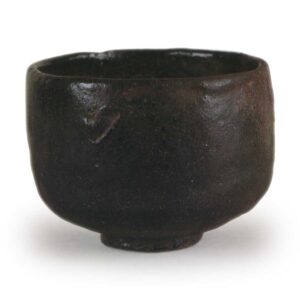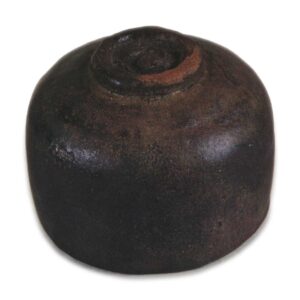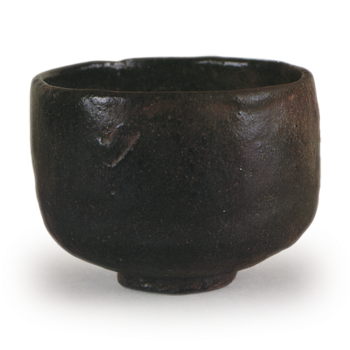

Important Cultural Property
Height: 8.5cm
Diameter: 10.7cm
Foot diameter: 4.8cm
Height: 0.8cm
Along with the Tōyōbō (black), Kimamori (red), and Hayafune (red) tea bowls, the Daikoku is known as one of the seven tea bowls with the Rikyū mark, and the fact that copies of the seven tea bowls were made by Ichiryu suggests that, during the Ichiryu period (the period of Kōzan and Zuiryu), these tea bowls were considered to be representative works of Rikyū’s taste, and were considered to be typical of the many Chōjirō tea bowls.
The fact that Daikoku was so famous is attested to by the fact that it is already mentioned in the “Ganki Meibutsu Ki” (A Record of Curios and Famous Objects) published in 1660 as “One large black tea bowl, owned by Rikyu, but the owner is unknown”. Incidentally, the only other Chojiro ware mentioned in the same book is the “Hayabune” bowl. Furthermore, although the same record states that it is “unknown who possessed it”, it is thought that it was owned by Goto Shosai or Esumi around the beginning of the Manji era.
As can be seen from the fact that it is thought to be a seven-flavored tea bowl, it is a typical tea bowl in the style favored by Rikyu, and of the existing tea bowls, it is similar in shape to the “Muichimono” tea bowl, and is simple and gentle, with a sense of mass that cannot be expressed in words. It is truly a symbol of the “tastelessness of the heart” of Rikyu’s later years.
Compared to the overall size, it is a little heavy to hold in the hand because of its thick base, so please refer to the cross-sectional drawing for an idea of this point.
The foot ring is rather small in comparison to the diameter of the bowl, and is not very high, and is rather modestly carved out. The inside of the foot ring is clearly shaped like a whirlpool, similar to the “Muichimono” bowl. As far as the technique of making the bowl is concerned, the foot ring is not necessary, so it is thought that this was done with the appearance of the foot ring in mind. What is more, the fact that it is so clearly and strikingly marked is a notable feature.
The whole piece is covered in black Raku glaze, but the glaze on the outside in particular is relatively smooth, and the unique amber-colored black glaze has melted well. However, there is a fairly strong crackle that appears to be hazy, from the foot ring to the rim. The inside has become matted with tea stains over the years, and it is likely that it has also become matted during use, but the luster has completely disappeared and it has a matte-like brown glaze.
There is no dent in the middle of the bowl where the tea would have collected, and it is only curved widely, but this could also be said to be a characteristic of early works.
Some of the glaze on the foot ring has been lost, revealing the so-called Jurakudo clay underneath. Also, the scissors marks left when it was removed from the kiln are clearly visible on the outside. There are some scratches on the outside, from the foot ring to the side, and there are several places where the lacquer has been repaired around the rim.
On the inside of the lid of the box, which has been painted with a black-lacquered finish on the front and a black-lacquered finish on the back, the following is written in red lacquer by Sōsa Esumi, the son of Sōtan Sen: “Ookuro, owned by Rikyū, passed down from Shōan to Sōtan, and then to Sōsa from Goto Shōsai (signature)”. “Daikuro” is the signature of Sen no Rikyu, and after that, it was passed down from Rikyu to Shōan and Sōtan, and for a time it belonged to the Kyoto tea master Goto Shōsai, but in the time of Esumi, it was passed down to the Fushian tea master



